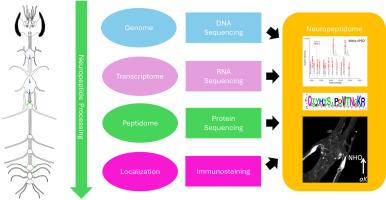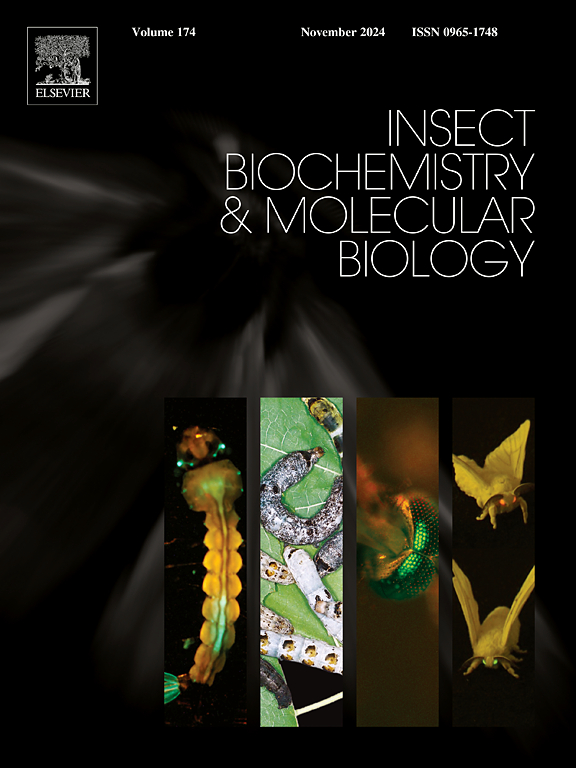Neuropeptide profiling of Bombus terrestris (Hymenoptera, Apidae) and comparative analysis across hymenopteran species
IF 3.7
2区 农林科学
Q2 BIOCHEMISTRY & MOLECULAR BIOLOGY
引用次数: 0
Abstract
Bombus terrestris is a Palearctic bumblebee species known for its excellent pollination activity. Due to its versatility, it has recently become a preferred species for greenhouse pollination worldwide. This species is also frequently used in experiments aimed at studying both the behavioral and physiological aspects of Hymenoptera. Key molecules in these research fields are neuropeptides, which regulate nearly all physiological processes in metazoans. In the current study, initial sequence identification and mass spectrometry analyses were conducted to identify processed neuropeptides in B. terrestris workers. The list of neuropeptide precursors was updated, and their distribution across the CNS was investigated using a combination of mass spectrometry and immunohistochemistry. Specific features of the B. terrestris peptidome were identified as well as those shared with other Apidae. In B. terrestris, some peptidergic systems were not identified, some of which are also absent in other Hymenoptera, while few neuropeptides, such as sulfakinin and corazonin, show derived sequences. Moreover, using mass spectrometry, for the first time, were identified neuropeptides from the abdominal transverse nerve neurohemal organ of Apidae and the presence of elevenin in the thoracic perisympathetic organs of B. terrestris was also reported. Additionally, a comparison of the B. terrestris capa gene structure with other hymenopteran species revealed a deletion in one exon shared by Apidae + Megachilidae, supporting the monophyly of long-tongued bees.

膜翅目蜂科土蜂神经肽谱及膜翅目间比较分析。
土大黄蜂是一种古北大黄蜂,以其出色的授粉活动而闻名。由于它的多功能性,它最近成为世界范围内温室授粉的首选物种。该物种也经常用于研究膜翅目昆虫的行为和生理方面的实验。这些研究领域的关键分子是神经肽,它调节着后生动物几乎所有的生理过程。在本研究中,采用初始序列鉴定和质谱分析的方法鉴定了土蚁工蚁的加工神经肽。更新了神经肽前体的列表,并使用质谱法和免疫组织化学相结合的方法研究了它们在中枢神经系统中的分布。鉴定了地芽孢杆菌肽酶的特异性特征以及与其他蚜虫科昆虫共有的特征。在土蜂中,一些肽能系统未被鉴定,其中一些在其他膜翅目昆虫中也不存在,而少数神经肽,如磺胺基肽和corazonin,显示衍生序列。此外,还首次利用质谱法鉴定出了蜜蜂腹部横神经神经血管器官中的神经肽,并报道了地鼠胸廓周围交感器官中11 - in的存在。此外,通过与其他膜翅目蜜蜂的基因结构比较,发现有一个外显子缺失,这与蜜蜂科和巨蜂科共有,支持长舌蜂的单系性。
本文章由计算机程序翻译,如有差异,请以英文原文为准。
求助全文
约1分钟内获得全文
求助全文
来源期刊
CiteScore
7.40
自引率
5.30%
发文量
105
审稿时长
40 days
期刊介绍:
This international journal publishes original contributions and mini-reviews in the fields of insect biochemistry and insect molecular biology. Main areas of interest are neurochemistry, hormone and pheromone biochemistry, enzymes and metabolism, hormone action and gene regulation, gene characterization and structure, pharmacology, immunology and cell and tissue culture. Papers on the biochemistry and molecular biology of other groups of arthropods are published if of general interest to the readership. Technique papers will be considered for publication if they significantly advance the field of insect biochemistry and molecular biology in the opinion of the Editors and Editorial Board.

 求助内容:
求助内容: 应助结果提醒方式:
应助结果提醒方式:


